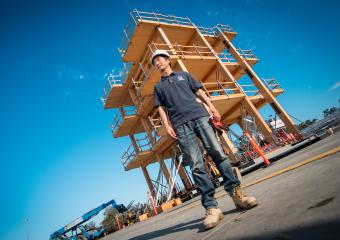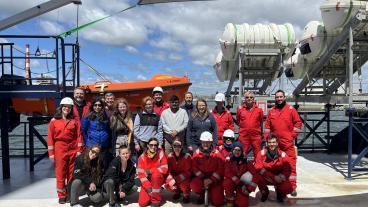How do tall timber buildings fare in earthquakes? Mines researcher is leading record-setting seismic test to find out
Shiling Pei, along with a consortium of universities, industry partners, will simulate a series of large earthquakes on a 10-story mass timber building this spring

A full-scale, 10-story mass timber building (shown here at four stories in August 2022) has been constructed on the shake table at the Englekirk Structural Engineering Center at the University of California San Diego. Dr. Shiling Pei, associate professor of civil and environmental engineering at Colorado School of Mines, is the principal investigator of the Natural Hazards Engineering Research Infrastructure (NHERI) TallWood project, which is being funded by the National Science Foundation. (Photo by David Baillot/University of California San Diego)
Buildings made of mass timber – layers of wood bonded together – are gaining popularity as greener and faster alternatives to concrete and steel structures. With new building codes recently updated to permit more high-rise mass timber buildings to be constructed in the United States, many have questioned how such buildings would fare in earthquakes.
The Natural Hazards Engineering Research Infrastructure (NHERI) TallWood project aims to investigate the resilience of tall timber buildings by simulating a series of large earthquakes on a full-scale, 10-story mass timber building this spring – the world’s tallest full-scale building ever tested on an earthquake simulator, or shake table. The research project is funded by the U.S. National Science Foundation.
“Mass timber is part of a massive trend in architecture and construction, but the seismic performance of tall buildings made with these new systems is not as well understood as other existing building systems,” said Shiling Pei, principal investigator and associate professor of civil and environmental engineering at Colorado School of Mines.
Pei’s team, which includes both researchers and practitioners, designed a 10-story tall, mass timber rocking wall lateral system suitable for regions with high earthquake hazard. This new system is aimed at resilient performance, which means the building will have minimal damage from design level earthquakes and be quickly repairable after rare earthquakes.
“The rocking wall system consists of a solid wood wall panel anchored to the ground using steel cables or rods with large tension forces in them,” Pei said. “When exposed to lateral forces, the wood wall panels will rock back and forth – which reduces earthquake impacts – and then the steel rods will pull the building back to plumb once the earthquake passes.”
Due to this seismic movement induced by the rocking system, resilience-critical nonstructural components within and covering the building, such as the exterior facade, interior walls and stairways, are in for a big ride.
“Resilient design must also account for the building’s nonstructural systems, which are not part of the structural load-resisting system, but play an important role in the building’s function and its ability to recover after the earthquake,” said Keri Ryan, a project co-investigator and engineering professor at the University of Nevada, Reno.
The project team focused on safety-critical nonstructural components that span floor-to-floor and thus are subjected to the relative movement between stories. The building features four exterior façade assemblies, a number of interior walls, and a 10-story stair tower. The exterior envelope must protect the building from temperature extremes and weather events, while stairs must remain functional to allow occupants to safely exit and first responders to continually access all floors of the building. “These assemblies have been designed with a variety of new and innovative details that are intended to accommodate the floor-to-floor movement without damage,” Ryan said. “Many of these details have never been tested in a rigorous building setting.”
The tests are scheduled to start in April at the University of California San Diego outdoor shake table — one of the two biggest earthquake simulators in the world. Located at the Englekirk Structural Engineering Center at the University of California San Diego, the facility is part of the NSF’s Natural Hazards Engineering Research Infrastructure. The shake table has the largest payload capacity in the world. It is capable of carrying and shaking structures weighing up to 2,000 metric tons, or 4.5 million pounds. The table was recently upgraded thanks to NSF funding and is now able to reproduce the full 3D ground motions that occur during earthquakes, when the ground is moving in all six degrees of freedom — longitudinal, lateral, vertical, roll, pitch and yaw. The combination of largest payload capacity in the world, an outdoor setting and the newly added six-degrees-of-freedom shaking capability make the UC San Diego shake table a powerful and unique facility – and the only one in the world where the Tallwood tests could happen.
Tests will simulate earthquake motions recorded during prior earthquakes covering a range of earthquake magnitudes on the Richter scale, from magnitude 4 to magnitude 8. This will be done by accelerating the table to at least 1g, which could accelerate the top of the building to as much as 3gs. For reference, fighter pilots experience up to 9gs of acceleration in flight.
In 2017, Pei’s team carried out a test on a two-story mass timber building by simulating shaking from the Northridge Earthquake, a magnitude 6.7 earthquake that struck Los Angeles in 1994. The building was subjected to 13 earthquake tests and remained structurally damage-free. In addition to demonstrating that mass timber building systems can be seismically resilient, those tests helped the research team develop the design and analysis methods that have been used for the 10-story building.
A consortium of universities are collaborating through NSF support on the NHERI TallWood project, including Colorado School of Mines (lead), University of Nevada, Reno, Colorado State University, University of Washington, Washington State University, University of California San Diego, Oregon State University, and Lehigh University. The project also received support from U.S. Forest Service, Forest Products Laboratory, and a number of industrial partners.
"To observe a full-scale tall building with a new lateral system that we believe will be resilient and even damage-free under large earthquakes—that is invaluable, not only for the science community but also the engineering community around the globe," Pei said. "This will add a more sustainable building option for seismically active regions.”
A shakedown for building construction
Globally, more than a billion people live in earthquake zones, and the urban population in these areas is expected to grow over the coming decades. The need for earthquake-safe buildings will become increasingly important, but safe structures in seismic zones haven’t traditionally been made from sustainable building materials — another concern for the future.
Pei hopes the upcoming tests will show that using wood materials is a sustainable alternative that’s also seismically sound—even in tall buildings.
All told, the researchers plan to run about 40 seismic simulations on the building, which is constructed with mass timber gravity framing and an innovative lateral system made of wood panels that freely rock to absorb an earthquake’s energy.
Rocking walls aren’t new — Pei said they were first tested and used with concrete construction. But concrete rocking walls tend to crack during large earthquakes and are difficult to repair. “The wood gives it another layer of resiliency guarantee,” he said. The team’s tall wood design uses mass timber construction that, rather than building a frame using smaller dimensional lumber such as two-by-fours, consists of large engineered wood panels glued or nailed together. In tall wood building design, the rocking wall is a wood panel with pre-stressed steel tension rods tying it to the foundation.
“The materials—just steel rods and wood panels—they’re not fancy, but with the design procedure developed in this project, you can target a certain level of earthquake intensity and make most of the building components to remain undamaged,” he said. “Because the post-tensioned steel rods will remain elastic during the earthquakes, the building can always come back to plumb after the shake.”
Even though building materials such as concrete and steel have a high carbon cost, using wood as a sustainable building material might still seem counterintuitive.
“There’s a forced perception that the lumber industry is cutting down forests,” Pei said. “But in most developed countries, the reputable wood industry companies are typically regulated to use wood from sustainably managed forests. Once you have a well-established industry, sustainability becomes something that they strive to achieve for their own benefit. They own the land, so they would like to keep growing trees again and again to make money out of it for the years to come.” The industry also manages the forests for fire because it will be their loss, he said. “Especially under climate change, if you don’t have the money and capital going in to take care of the forest, it can end up getting impacted more negatively by climate change.”
Countries that already have a rich tradition of building with timber have already shown their interest in this style of building.
“In Europe and Japan, they have heavy timber tradition as part of their history, so they’ll be the early adopters,” Pei said. “I firmly believe in the U.S., we’ll also be a big player in mass timber, because we use a lot of wood material in existing building stock already.”
At full scale, the shake table test of a 10-story building will provide an incredible proof-of-concept for the construction industry and the public in places like California, British Columbia, and earthquake-prone cities in Italy and Japan, where Pei said they have active research and industry collaborators in the project.
"To observe a full-scale tall building with a new lateral system that we believe will be resilient and even damage-free under large earthquakes—that is invaluable, not only for the science community but also the engineering community around the globe," Pei said. "This will add a more sustainable building option for seismically active regions.”
The project is supported by the National Science Foundation (grants 1636164, 1635363, 1635227, 1634628, 1634204, 1635156). The NHERI shake table facility operates through NSF support under cooperative agreement 2227407 and was recently upgraded under cooperative agreement 1840870.




